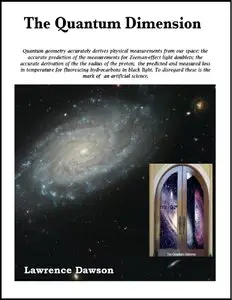The Quantum Dimension:Phenomena Discovered and Confirmed by Quantum Geometry by Lawrence Dawson
English | Jan 1, 2010 | ISBN: 0941995240 | 314 Pages | AZW4/PDF (True) | 17.72 MB
English | Jan 1, 2010 | ISBN: 0941995240 | 314 Pages | AZW4/PDF (True) | 17.72 MB
This book offers solutions to the defective quantum mechanical atomic model of de Broglie, Bohr, and Schrodinger. The quantum mechanical model is actually an attempt to probe an unrecognized four-dimensional quantum geometric structure, a structure which is outlined in the book. Quantum mechanics probes four-dimensional structure by using mystified, geometrically schizophrenic and nonlinear mathematics. The quantum mechanical model has failed in several important ways. First, it has failed to identify the energy states of the shell/subshell schematic for the periodic table of elements. It is demonstrated in the book that quantum mechanics are groping for the actual four-dimensional structure. This four-dimensional structure does provide the energy distributions into the shell/subshell electron orbital schematic.
Secondly, the quantum mechanical model has failed to provide adequate explanation of the hydrogen electron s fine structure. Specifically, a precise and accurate formula identifying the causes underlying Zeeman effect light doublets has not been delivered. However, using four-dimensional quantum geometry, Zeeman doublets as defined by changes in electron voltage are demonstrated to be a mathematical function of the electron voltage of shells/subshells (as identified four-dimensionally), of the four-dimensional anomalous magnetic moment of electron 1/ 2 spin and of a four-dimensionally identified wave-phase time constant. In contrast to this explanation of Zeeman doublets as a function of measured and calculated independent variables, the quantum mechanical model offers explanations by fiat. The phenomenon is addressed solely by a conceptual model; not as a dependent variable output by known independent variables, as with the four-dimensional model.
Third, the quantum mechanical model provides an incorrect formula for the capacity of subshells to accommodate electrons. This failure is due to a misunderstanding of the Schrodinger electron orbital wave function. The Schrodinger wave function is shown to be a correct dimensional shift of an electron orbital from four-dimensional space to three dimensional space. However, a geometric misunderstanding of the Schrodinger dimensionally-shifted orbital led to an inaccurate formula for subshell electron capacity. When corrected by the actual four-dimensional model, a different shell/ subshell schematic for the periodic table of elements is indicated.
Finally, the naturally occurring sodium D-lines (a light doublet) are used to prove that the four-dimensional subshell electron infill capacity is correct. It is postulated that the D-lines occur because the sodium atom is attempting to place its eleventh and last electron in the 6g subshell which has a predicted capacity of 10 electrons. A comparison of Zeeman effect D-lines doublets (when the D-lines are put under a magnetic field) and the predicted 6g doublet demonstrate that there are 10 electrons opposing the eleventh s entry into the subshell. The quantum mechanical model predicts there is an 18 electron capacity for g subshells. These data prove there is only a 10 electron capacity for the g subshell as predicted by the four-dimensional model.
Acceptance of four dimensional quantum geometry faces an uphill battle. The geometry proposes a four-dimensional vacuum space which people will have difficulty visualizing. We seem to be hard wired to perceive our environment in only three Euclidean dimensions. The premise of this geometric system is that vacuum space cannot be accurately graphed using the standard three Cartesian axii but can only be described as composed of vacuum solitons as established by the squared value of an unrecognized quantum dimension.
The soliton is established by a Euclidean dimensional axis set at 90° to the quantum axis.



